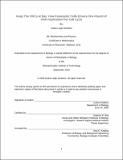| dc.contributor.advisor | Stephen P. Bell. | en_US |
| dc.contributor.author | Amasino, Audra Leigh. | en_US |
| dc.contributor.other | Massachusetts Institute of Technology. Department of Biology. | en_US |
| dc.date.accessioned | 2021-01-05T23:11:33Z | |
| dc.date.available | 2021-01-05T23:11:33Z | |
| dc.date.copyright | 2020 | en_US |
| dc.date.issued | 2020 | en_US |
| dc.identifier.uri | https://hdl.handle.net/1721.1/128988 | |
| dc.description | Thesis: Ph. D., Massachusetts Institute of Technology, Department of Biology, 2020 | en_US |
| dc.description | Cataloged from student-submitted PDF of thesis. | en_US |
| dc.description | Includes bibliographical references. | en_US |
| dc.description.abstract | During each cell cycle, eukaryotic cells must faithfully replicate their genome, ensuring exactly one full copy is made. Both under-replicating or over-replicating the genome can have deleterious consequences including cell death, genome instability and cancer. Thus, this process is tightly regulated. The major mechanism to ensure that DNA is replicated once per cell cycle entails the temporal separation of two key replication events: helicase loading and helicase activation. Helicase loading occurs during the G1 phase of the cell cycle. In S. cerevisiae cells, Cyclin-Dependent Kinases (CDKs) prevent helicase loading outside of G1 by phosphorylating three of the four helicase-loading proteins: Mcm2-7, Cdc6, and the Origin Recognition Complex (ORC). Phosphorylation of free Mcm2-7 and Cdc6 leads to their removal from the nucleus (Mcm2-7 by nuclear export and Cdc6 by protein degradation). However, phosphorylated ORC remains in the nucleus bound to origins. | en_US |
| dc.description.abstract | ORC phosphorylation intrinsically inhibits the helicase loading reaction. In in vitro reconstituted helicase loading reactions, CDK phosphorylation of ORC is sufficient to completely inhibit helicase loading. However, the precise event(s) during helicase loading that are affected by ORC phosphorylation were not known prior to this study. To identify the steps of helicase loading that are inhibited by ORC phosphorylation, we used single-molecule microscopy to compare the progression of helicase loading with phosphorylated versus unphosphorylated ORC. Successful helicase loading results in two head-to-head Mcm2-7 helicases encircling DNA. We show that ORC phosphorylation prevents loading of both the first and second Mcm2-7 complexes. An initial intermediate in helicase loading containing origin DNA and all four proteins (the OCCM) still forms when ORC is phosphorylated, albeit slower. | en_US |
| dc.description.abstract | Focusing on events after OCCM formation, we found that ORC phosphorylation alters Cdt1 dissociation kinetics and inhibits successful Mcm2-7 ring closing. ORC is phosphorylated on both the Orc2 and Orc6 subunits in vivo; we find that in vitro phosphorylation of either single subunit leads to nearly identical effects as phosphorylation of both subunits. My studies suggest a model in which ORC directly controls Mcm2-7 ring closing through physical interactions with both Cdt1 and Mcm2-7 and these interactions, and thus ring closing, are inhibited by ORC phosphorylation. | en_US |
| dc.description.statementofresponsibility | by Audra Leigh Amasino. | en_US |
| dc.format.extent | 141 pages | en_US |
| dc.language.iso | eng | en_US |
| dc.publisher | Massachusetts Institute of Technology | en_US |
| dc.rights | MIT theses may be protected by copyright. Please reuse MIT thesis content according to the MIT Libraries Permissions Policy, which is available through the URL provided. | en_US |
| dc.rights.uri | http://dspace.mit.edu/handle/1721.1/7582 | en_US |
| dc.subject | Biology. | en_US |
| dc.title | Keep the ORCs at bay : how eukaryotic cells ensure one round of DNA replication per cell cycle | en_US |
| dc.title.alternative | How eukaryotic cells ensure one round of DNA replication per cell cycle | en_US |
| dc.type | Thesis | en_US |
| dc.description.degree | Ph. D. | en_US |
| dc.contributor.department | Massachusetts Institute of Technology. Department of Biology | en_US |
| dc.identifier.oclc | 1227031344 | en_US |
| dc.description.collection | Ph.D. Massachusetts Institute of Technology, Department of Biology | en_US |
| dspace.imported | 2021-01-05T23:11:32Z | en_US |
| mit.thesis.degree | Doctoral | en_US |
| mit.thesis.department | Bio | en_US |
